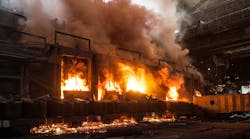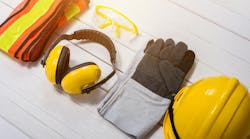Take these precautions when working around combustibles:
- Before working above or adjacent to combustibles, ensure there is an egress path that won’t be blocked by flame or intense smoke. If combustibles are near the exit, move them if at all practical.
- Depending upon the combustibles, wear or carry escape personal protective equipment (PPE). For example, if the combustibles are highly toxic when burned, carry an escape respirator.
- Remove and/or de-energize (lockout/tagout) ignition sources near combustibles.
- If you are going to introduce an ignition source in an area close to combustibles, ensure a qualified fire watch attendant is present.
- Erect barriers between the work area and the combustibles or remove the combustibles.
- If using portable heaters in an area containing combustibles, note the recommended distance for each heater and maintain it always.
- If erecting a temporary shelter (for example, to conduct a test outdoors), don’t use scrap wood or other combustible materials. There are approved methods and materials for this purpose, use those only.




